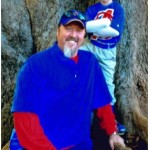Is This My Hill to Climb?: Recollections of Determination
Chelsea Levo Feary | March 2, 2020
Chelsea Levo Feary | March 2, 2020
Recently, I watched a video of a mama-bear and her cub climbing up a steep snow-covered mountain. As they scaled the mountain side at a quick pace, they would slip and slide back down. However, backsliding didn’t seem to phase the bear and her cub as they continued to climb. As the mother bear reached the top of the mountain, she looked down at her little one as it diligently dug in and climbed toward her. Just as the cub was about to reach the top and join his or her mother, the mama-bear swiped her paw down at the cub knocking it out of reach as the cub slid nearly all the way back to the bottom of the mountain. As I gasped while watching this, the cub quickly scurried right back up to the top where it was able to finally join the mother. The obstacles of a snowy slick surface, a steep incline, and continued backsliding didn’t get in the way of the two bears determination to reach their destination, but most endearing to me was the mother bear’s determination to teach her cub by example and lesson to overcome those obstacles and not give up in order to achieve a goal. I often ask myself when presented with a challenge, “Is this my hill to climb?” and in this case, it literally was for the bears.
Determination is “overcoming obstacles in order to reach my goal,” and as defined has three components – goals, obstacles, and overcoming. It is not hard to think of someone who historically or famously achieved something and admire them for their determination. From Moses who led the Israelites out of Egyptian slavery into the promised land, to Gandhi who fought for the independence of India from British rule through non-violent protesting, to Rosa Parks who refused to give up her seat on a city bus in resistance to racial segregation, these examples serve as motivation and a reminder that nothing worthwhile is easy.
An Oklahoman who is lesser known, but no less determined is a man named Stanley Rother. This Oklahoma farm boy from Okarche was ordained a Catholic priest in 1963. After serving as an associate pastor for five years in Oklahoma, he heeded a calling and joined the diocese’s mission at Santiago Atitlan, Guatemala. Father Rother connected with the people immediately. In order to serve the people, there, he had to learn to speak two different languages. One of the languages was not a written language until the Oklahoma mission arrived. Learning their language and culture enabled Father Rother to celebrate Mass in their language and translate the New Testament. He lived a simple life with his people, ministering to them in their homes, nursing the sick, and even putting his farming skills from Okarche to use by working with them in the fields. While in Guatemala, a civil war raged between the militarist government forces and the guerillas. The Catholic Church was caught in the middle of the conflict for ministering to and educating the people. During this conflict, thousands were killed and eventually, Father Rother’s name appeared on a death list. Father Rother, for his safety, reluctantly returned home to Oklahoma. He did not stay long. He was determined to give his life for his people stating, “The shepherd cannot run.” He returned to Santiago Atitlan and continued the mission. Within a few months of his return, on July 28,1981 Father Rother was brutally murdered. Father Rother died for his faith. Blessed Stanley Rother was beatified on September 23, 2017. This is the final stage before canonization as a saint. He is the first American-born martyr and the first U.S. priest to be beatified.[i]
When we tap into our own lives, each of us has a story about how we or someone very close to us has given everything they have to accomplish or overcome something. We should keep those stories close to the surface and remember them when we are looking for motivation for determination that answers the question, “is this my hill to climb?”
In conclusion, a documentary I recently watched about the Roosevelts comes to mind. One day, President Roosevelt and Eleanor were both sitting in FDR’s office reminiscing about visits with Theodore Roosevelt at Sagamore Hill that each of them had made when they were children. Eleanor remembered when they went swimming with Uncle Ted, he would suggest all the children run down the dune to Oyster Bay.
“It was awfully steep,” FDR said, “the sand went down with you and you were darned lucky if you didn’t end up half way down going head over heels.”
“And climbing back up,” Eleanor recalled, “you slipped down one step for every two you took, but you kept at it and eventually, the fear was worn away.” [ii]
[i] www.stanleyrother.org
[ii] The Roosevelts: An Intimate History, Dir. Ken Burns, Episode 7 (2014)
Originally published in the Owasso Reporter

 Maturity doesn’t come with age; it comes with acceptance of responsibilit...
Maturity doesn’t come with age; it comes with acceptance of responsibilit...